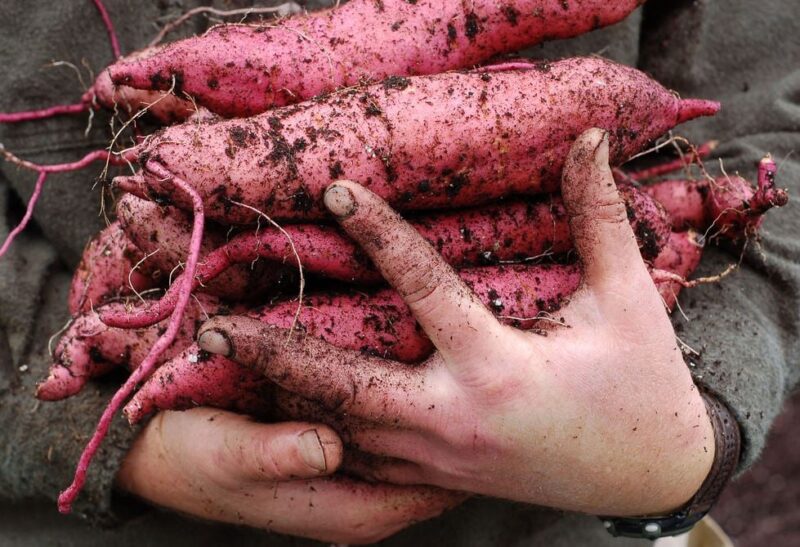Sweet potatoes have become one of the most common vegetables in gardens and kitchens around the world. Originating from South America over 5000 years ago, these tender warm-season annuals require careful timing and conditions to flourish and reach their full potential.
Growing them is possible in practically all the regions and weather conditions, which makes them quite accessible. Today, let us talk about when they should be harvested, but also about other relevant information about sweet potatoes.
Important Signs
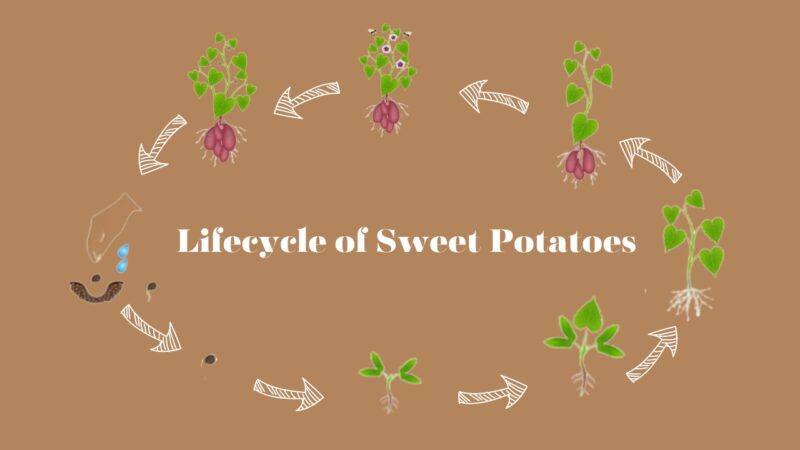
It typically takes 4 to 5 months in total. Gardeners look forward to late summer and early fall when the first signs of maturity emerge.
| Stage | Duration | Signs of Progress |
|---|---|---|
| Slip Planting | Day 1 | Slips begin to establish and grow. |
| Early Growth | 0-3 months | Visible growth of vines and leaves, establishment of root system. |
| Mid to Late Growth | 3-4 months | Foliage thickens, tubers begin to form and expand underground. |
| Maturity Indication | 4-5 months | Tubers reach full size, enhanced flavor profile. Foliage turns yellow and starts to die back. |
| Harvest | Late summer to fall | Harvested tubers ready for curing and storage. |
Unlike regular spuds that grow straight from seeds, these storage roots develop from sprouts – small shoots planted after any risk of frost when soil hits at least 65 degrees. They love sunlight, requiring a minimum of 6 hours of direct rays each day. Early on, the plants can be sensitive to dry spells too.
Optimal Conditions
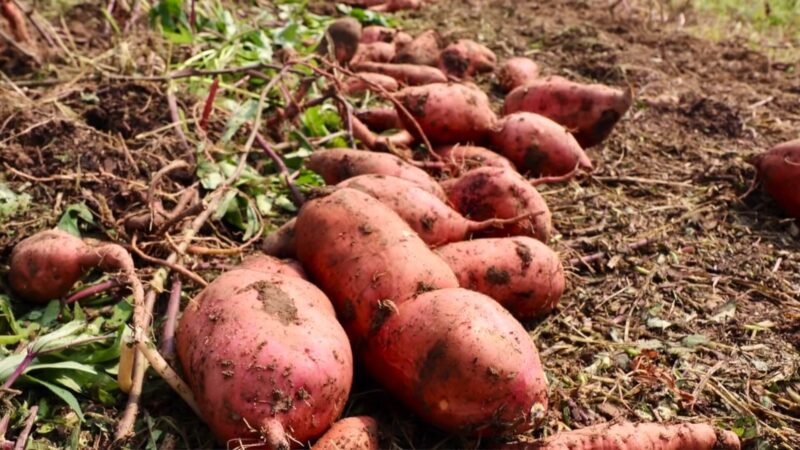
Harvesting sweet potatoes at the optimal time, under suitable conditions, is key to maximizing quality and storage longevity. The best window is during dry weather before fall frosts arrive. There are good reasons for this timing:
- Disease Prevention: Dry conditions help minimize the risk of fungal diseases and rot, which thrive in moisture. Harvesting in dry weather reduces the likelihood of these issues, ensuring that the sweet potatoes are in the best condition when harvested.
- Tuber Quality: The quality of sweet potatoes is at its peak just before the onset of cold weather. The tubers have had ample time to mature and develop their full flavor and nutritional profile.
- Damage Avoidance: Frost can damage sweet potatoes, affecting their texture and taste. By harvesting before the frost, you ensure that the tubers remain undamaged and suitable for storage.
For container gardens, timing may differ slightly – around four months after planting. As with ground plots, observing foliage changes from green to yellow is a reliable indicator of maturity.
| Factor | Ground-Planted Sweet Potatoes | Container-Grown Sweet Potatoes |
|---|---|---|
| Ideal Harvest Time | Before the first frosts of fall | Around four months after planting |
| Weather Conditions | Dry weather | Dry weather |
| Indicators of Maturity | Foliage turns yellow and dies back | Foliage turns yellow and dies back |
| Risks of Early Harvest | Smaller, less flavorful tubers | Smaller, less flavorful tubers |
| Post-Harvest Handling | Cure in dry, high-humidity conditions | Cure in dry, high-humidity conditions |
Harvesting Technique
The technique used in harvesting sweet potatoes is as important as the timing.
Gentle Extraction
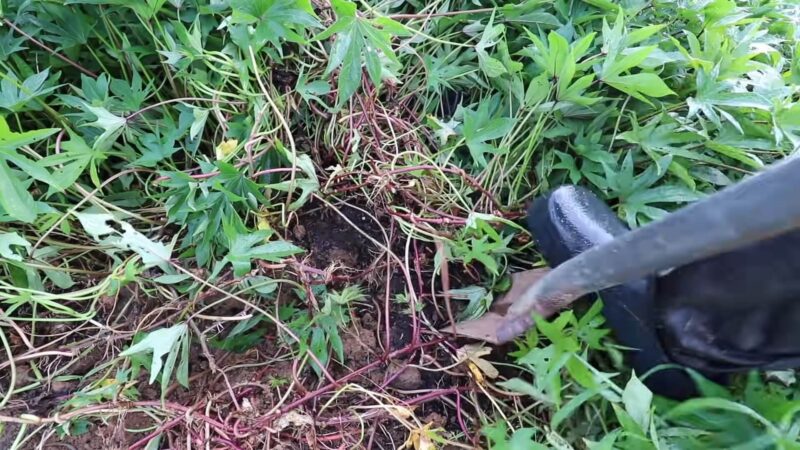
Gently insert the garden fork or spade into the soil at a slight distance from the main stem of the sweet potato plant.
If the soil is dense, you may need to work around the plant in a circle, loosening the earth gradually until the tubers can be lifted out with minimal resistance.
Handling and Initial Cleaning
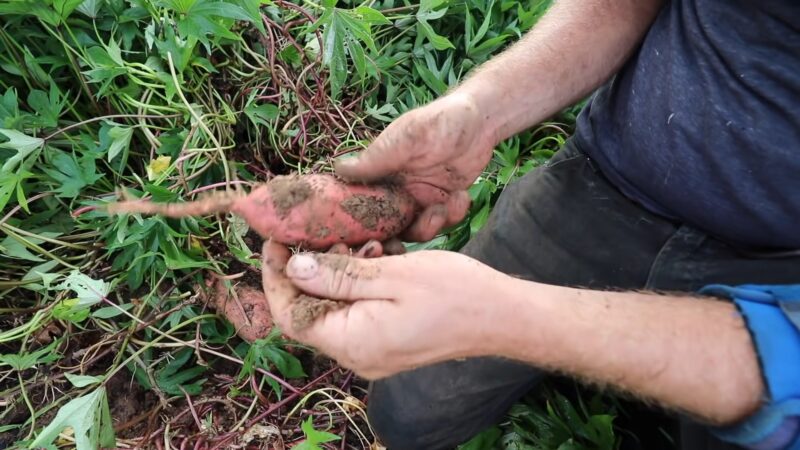
Once lifted from the soil, handle the sweet potatoes with care. Their skins are very delicate at this stage and can be easily bruised or scratched, leading to potential entry points for disease during storage.
Shake off any loose soil gently, but avoid washing the tubers, as moisture can promote rot. If there’s stubborn soil, it’s better to leave it until after the curing process, as the skin will harden and make cleaning easier and safer for the sweet potato.
Curing Process
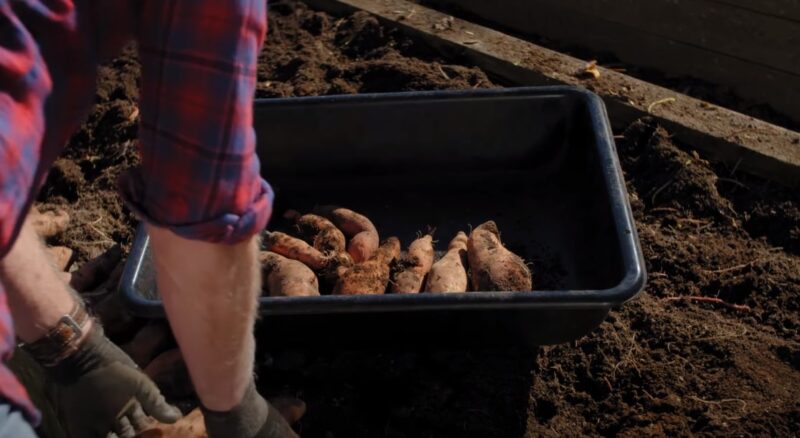
The curing process is vital for several reasons. It helps heal any minor damage to the skin, reduces the potential for storage diseases, and enhances the sweet potatoes’ natural sweetness. To cure sweet potatoes, space them apart in a single layer in a well-ventilated, dry area with high humidity, ideally around 85-90%.
The temperature should be kept around 80-85°F.
The sweet potatoes should remain in these conditions for about two weeks. During this time, the skin will harden, and the flesh will become sweeter and more flavorful.
Storage
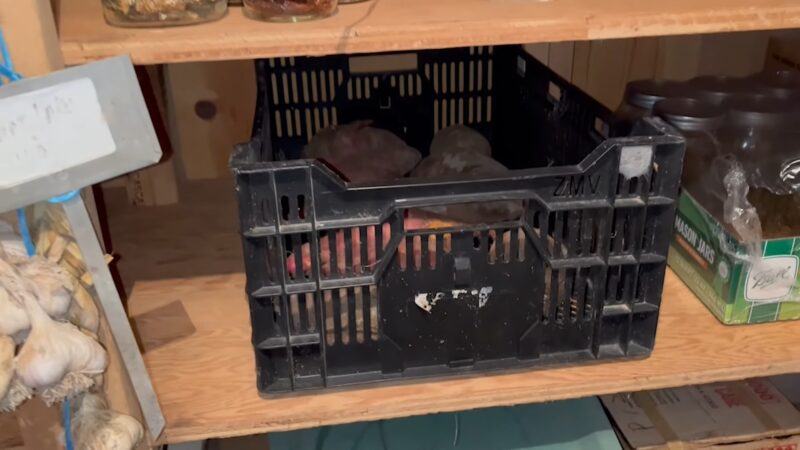
The optimal storage temperature for sweet potatoes is between 55-60°F (13-16°C). This range is slightly warmer than a typical refrigerator but cooler than room temperature, making locations like basements, cellars, or a cool pantry ideal for storage. The humidity level should also be high, around 85-90%, to prevent the tubers from drying out.
These conditions mimic the natural environment in the ground, helping to maintain their texture and flavor.
Summary
Knowing when to harvest sweet potatoes is crucial for gardeners aiming to achieve the best yield, flavor, and storage life from their crop. The optimal time for harvesting is when the foliage begins to turn yellow and die back, typically occurring in late summer to fall, before the first frosts.
Timing ensures that the sweet potatoes have matured properly, offering the richest taste and nutritional value. It’s also essential to handle the sweet potatoes gently during harvest to prevent damage to their delicate skins, followed by a proper curing process to enhance their sweetness and extend their shelf life.

